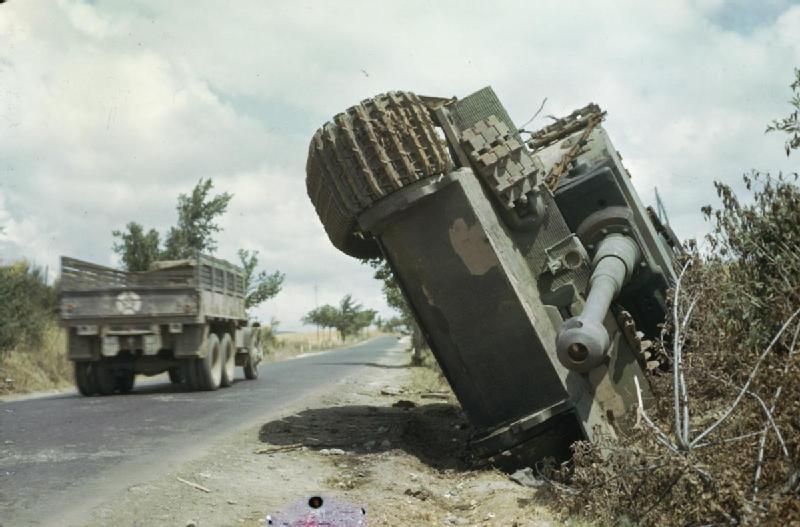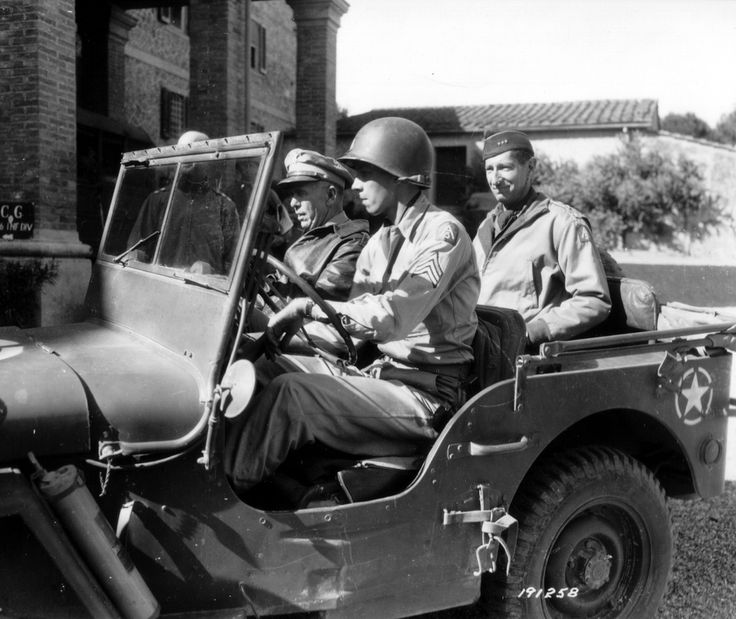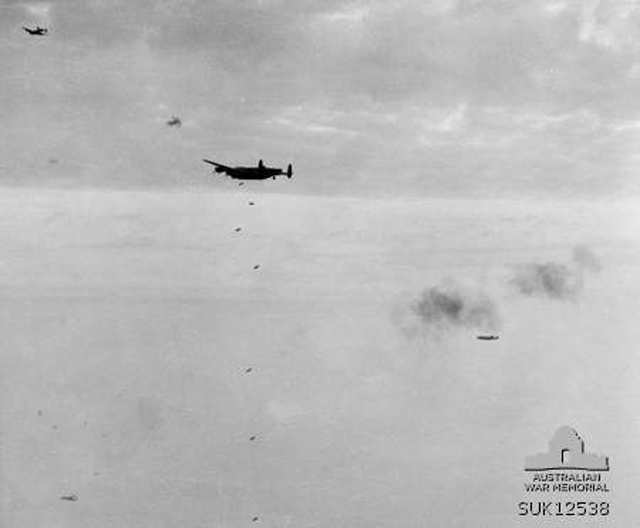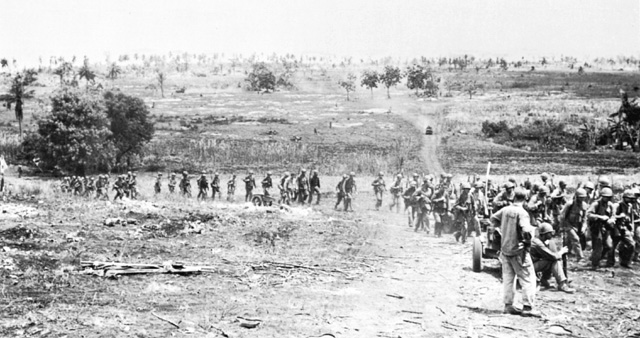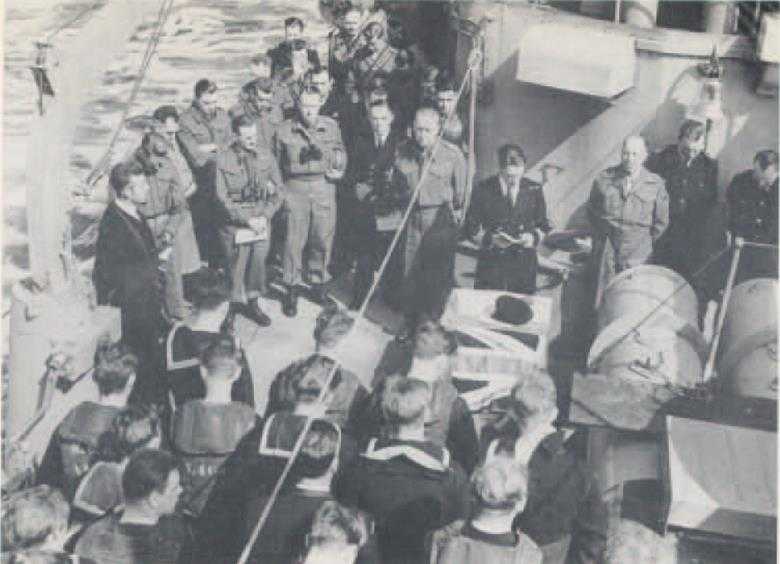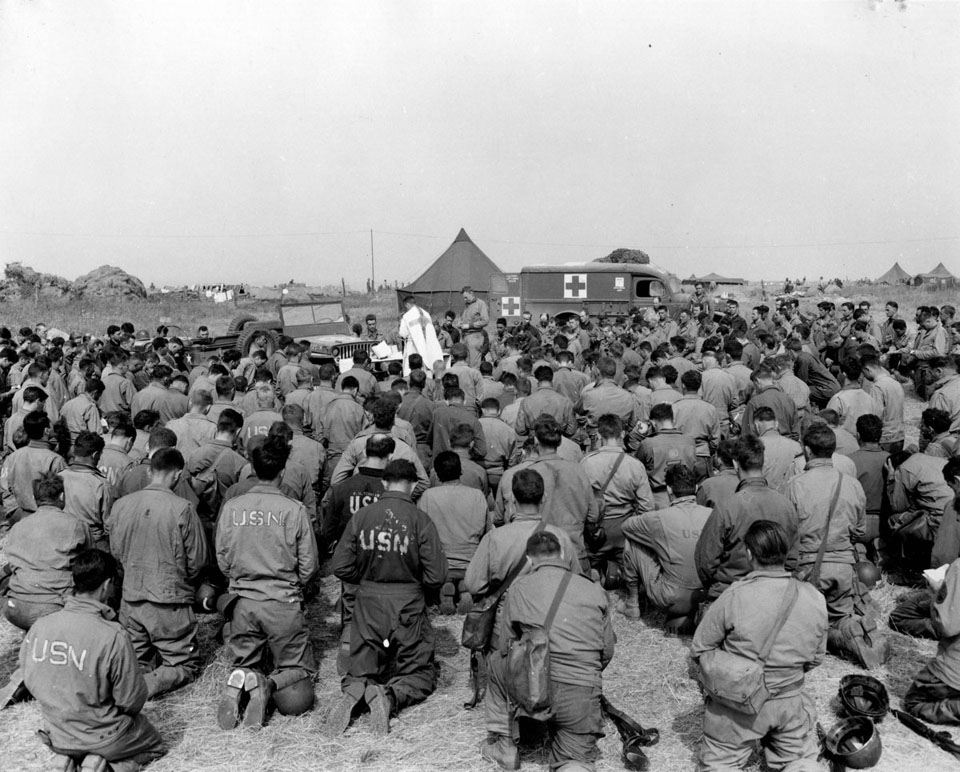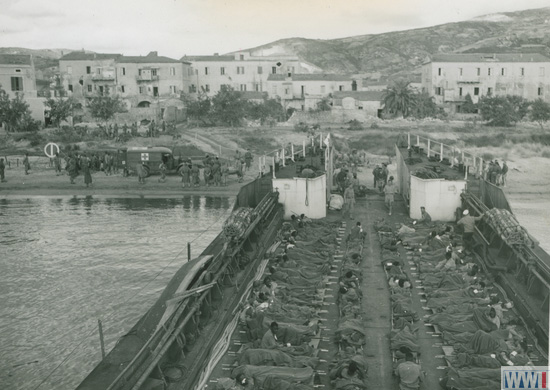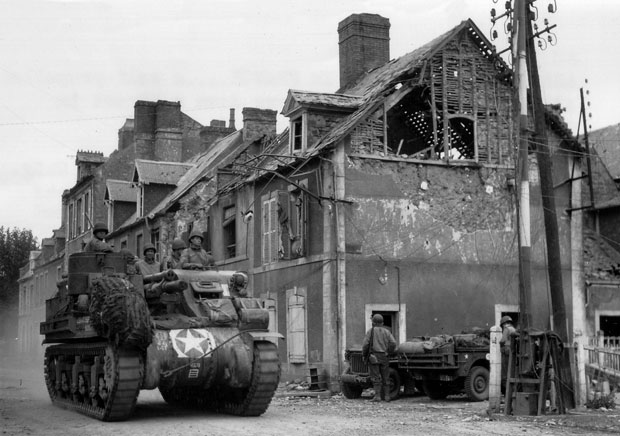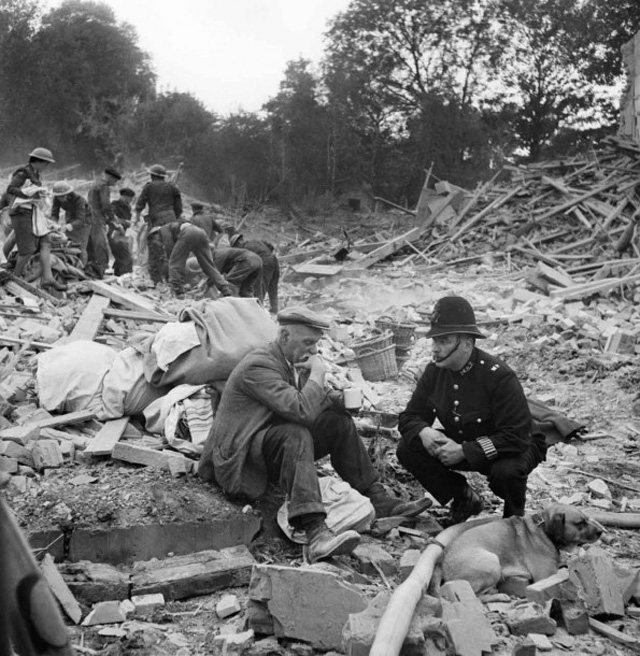Air Operations, Carolines
34 XIII Bomber Command B-24s attack the Truk Atoll.
[Air Operations, CBI
BURMA- 16 10th Air Force fighter-bombers attack Mogaung and Myitkyina.
- 341st Medium Bomb Group B-25s and 14th Air Force P-40s attack Yoyang and shipping in the Siang-Chiang River delta.
- P-51s and P-40s attack an estimated 100 supply boats on lower Tungting Lake.
- P-51s and P-40s strafe a village near Changsha and Japanese Army cavalry between Changsha and Siangyin.
- 5th CACW Fighter Group P-40s down 4 Ki-43 'Oscar' fighters near Changsha at 0830 hours.
- A 449th Fighter Squadron P-38 downs a Ki-43 'Oscar' fighter over Anking during a late-morning engagement.
- A 51st Fighter Group P-40 downs a Ki-27 'Nate' fighter near Hsuchang during the morning.
- 76th and 26th Fighter squadron P-51s down 3 Ki-43 'Oscars' in an early-afternoon engagement near Changsha.
Air Operations, Europe
A V-1 destroys the Guards Chapel, Wellington Barracks, London, killing 119 and injuring 102.
RAF BOMBER COMMANDEvening Ops:
- In a period of bad flying weather, 10 Mosquitos are sent to hit a large concrete flying-bomb storage facility in the woods at Watten, near St Omer. 9 aircraft bomb, but the results are unknown.
- There are no losses.
- 5 Halifaxes and 2 Stirlings lay mines off Brest and St Malo.
FRANCE:
- 58 2nd Bomb Division B-24s, escorted by 48 P-47s, attack V-weapons sites at Watten using GH raday, but a planned attack by VIII Fighter Command P-38 and P-47 fighter-bombers against rail bridges in teh St. Quentin area is aborted due to bad weather.
- In the first large strategic mission since D-day, 1,378 8th Air Force B-17s and B-24s are dispatched to attack oil refineries around Hamburg and Misburg (Hannover), and two Luftwaffe control centers. Bad weather encounterd along the way results in more than 150 aborts, and many bomber formations must settle for secondary targets and targets of opportunity, especially the city of Hamburg, which receives the brunt of many piecemeal attacks. The city of Hannover and the Misburg refineries are also struck, as is the city of Bremen, several other towns and cities, and several Luftwaffe airdromes.
- 7 B-17s and 4 B-24s are lost
- Escort for the heavy bombrs is provided by 537 VIII Fighter Command fighters.
- There are no losses, and no victories claimed
FRANCE:
- During the morning, nearly 130 IX Bomber Command B-26s and A-20s attack marshalling yards at Meudon and Rennes, and fuel dumps at two locations.
- During the afternoon, IX Bomber Command B-26s attack three V-weapons sites through heavy cloud cover.
- Throughout the day, 9th Air Force fighter-bombers attack transportation and tactical targets in the Cherbourg Peninsula.
- The only victory of the day is awarded to a 406th Fighter Group P-47 pilot who downs a Bf-110 near Trouville-sur-Mer at 2045 hours.
- An advance echelon of P-47s from the 9th Air Force's 48th Fighter Group begins operating out of Advance Landing Ground A-4, at Deaux Jumeaux in Normnady, to provide direct support for Allied ground forces in the beachhead area.
ITALY:
- All 12th and 15th Air Force bombers are grounded again by bad weather, XII TAC fighter-bombers are able to attack several gun emplacements on Elba Island and some coastal shipping near Piombino.
Air Operations, Marianas
In the opening move of the Battle of the Philippine Sea, 9 Yap-based G4M 'Betty' bombers searching for Task Force 58 miss that target but instead locate a Fifth Fleet escort carrier group southeast of Saipan. As a result of this sighting report, 6 P1Y 'Galaxy' bomber and 11 A6M Zeros from Yap and 38 A6M Zeros and 1 D4Y 'Judy' dive bomber from Palau are sent to attack the escort carriers. They miss the target but at 1545 hours attack a group of fleet oilers, of which they damage 3.
US carrier F6Fs and FMs down a B6N 'Kate' carrier-based reconnaissance plane, 4 G4Ms 'Betty' bombers, 1 E13A 'Jake' reconnaissance float plane, 1 D4Y 'Judy' dive bomber, and 1 Ki-61 'Tony' figher between 0755 and 1630 hours. The D4Y pilot is captured, a rare event. Throughout the day, 19 US carrier fighters and 1 pilot are lost in operational accidents.
- Elements of the US 27th Infantry Division capture the Aslito airfield on Saipan, from which VMO-2 and VMO-4 OYs immediately begin operating.
- The torpedo-damaged escort carrier USS Fanshaw Bay retires toward Eniwetok.
- During the afternoon, several 1st Mobile Fleet carrier-based search aircraft locate Task Force 58.
- During the evening, Japanese Navy bombers attack troop-laden US transports. 1 LST is mortally damaged and later scuttled. Escort-carrier FMs down 9 Ki-61 'Tony' fighters, 1 Ki-45 'Nick' fighter, and 2 J1N 'Irving' fighters near Saipan between 1630 and 1730 hours. A VC-10 TBM and a VC-10 FM each down a P1Y 'Galaxy' bomber over the escort carriers at 1800 hours. VC-5 FMs down 9 A6M Zeros over Saipan and Tinian between 1810 and 1820 hours.
Air Operations, New Guinea
V Bomber Command B-25s and A-20s, V Fighter Command fighter-bombers, and RAAF aircraft attack supply dumps and other targets in the Wewak area.
[Battle of the Atlantic
U-767 is located by D/F by the 14th Escort Group comprising HMS Fame, Hotspur, Inconstant, Icarus and Havelock. Fame attacks first with Hedgehog and soon hears 3 explosions which in effect ended the U-boat. Attacks by the other ships are carried out, but the first attack did the job.
| Class | Type VIIC |
| CO | Oberleutnant zur See Walter Dankleff |
| Location | English Channel, SW of Guernsey |
| Cause | Hedgehog, depth charge |
| Casualties | 48 |
| Survivors | 1 |
Battle of the Philippine Sea
The US forces make their rendezvous west of the Marianas while the Japanese continue to approach. The Japanese are heavily outnumbered by US Task Force 58, which includes 7 battleships, 14 carriers (7 heavy), 21 cruisers, and 69 destroyers. Late in the evening the Japanese scout planes sight the American fleet. This is the only advantage that the Japanese have and comes about principally because their scout planes have a longer range. The Japanese plan to launch their strike planes early the next day while still at very long range and, after attacking, to have them fly on to Guam where the local forces can protect them while they refuel and rearm. Once this is done they can attack again on the return journey. The glaring weakness in this plan is that the air forces on Guam have suffered seriously from American attacks recently and have failed to inform the fleet of this. In fact this shortcoming is less significant that might have been the case as the American ships exact such a heavy price from the first attacks.
[CBI
BURMAThe NEW GALAHAD Force cuts the Mainga Ferry Road, the main supply route for the Japanese defending Myitkyina. Activity of the Allied forces in this area subsides to patrolling and skirmishing.
On the Salween front, in the Shweli Valley, the Chinese 36th Division of the 54th Army begins an assault on Watien, and the 116th and 130th Divisions reach positions near Chiangtso, 4 miles southeast of Watien.
CHINAJapanese troops of the 11th army capture the cities of Chuchow and Changsha, which the Chinese have abandoned.
[China
Japanese troops of the 11th army capture the cities of Chuchow and Changsha, 322 km south of Hankow.
[Eastern Front
The Leningrad front breaks through the main Finnish positions on the Mannerheim line and advance toward Viipuri.
[Italy
Units of the 1st Motorized Division of the French Expeditionary Corps under Gen Alphonse Juin reach Radicofani, northwest of Orvieto, overlooking the road from Florence to Rome.
The British 8th Army CG decides to confine the advance of the X Corps beyond Perugia to the road through Umbertide and Citta di Castello instead of along Route 71 as originally planned. The XIII Corps, making the main effort, is to use Route 71 and a secondary road through Sinalunga. British columns converging on Perugia are meeting delaying opposition near the town. The Germans quietly abandon their positions at Citta della Pieve, in the XIII Corps zone, during the night of the 18th.
[Marianas
The advance of the 4th Marine Div reaches the west side of Saipan at Magicienne Bay. The Japanese forces are thus separated into two. Parts of the 27th Div on the right of the 4th Marines, captures Aslito airfield. Japanese air strikes sink 1 destroyer and 2 tankers offshore as well as damaging the escort carrier Fanshaw Bay (CVE-70). Much of the air cover and close support has been withdrawn to prepare to take part in the imminent fleet battle although the guns of the US Navy and landing craft prevent the Japanese from bringing reinforcements up against the Tanapag Harbor beachhead, north of the harbor itself. Taking advantage of the absence of American aircraft, Japanese air forces attack American shipping and beachheads, losing about 20 aircraft by anti-aircraft fire.[SAIPAN]
[New Guinea
On Biak, TF HURRICANE is regrouping and getting into position for a final assault to clear the entire region from which the enemy can fire on the Mokmer airfield. The 34th Infantry, 24th Division, arrives from Hollandia and takes over the positions of the 186th Infantry west of the Mokmer airfield. Gen Fuller leaves Biak to take his new position as SEAC (Southeast Asia Command). Gen Doe replaces Gen Fuller as CG of the 41st Division.
Gen Krueger informs Gen MacArthur that he prefers to use the 112th Cavalry RCT to reinforce Aitape rather than break up the 31st Division. Gen Walter Kreuger order Gen Sibert to begin an offensive in the Wakde-Sarmi area. Sibert plans to attack to the west from the Tirfoam River on the 20th with the 20th Infantry, which the 1st Infantry is to relieve for this purpose.
[Pacific
- The US destroyer Phelps (DD-360), along with infantry landing craft (gunboat) LCI(G) and amphibian tractors LVT(A), oppose between 25 and 30 Japanese landing barges, southward-bound off Garipan, Saipan, sinking 13 and putting the rest to flight.
- The US motor torpedo boats PT-63 and PT-107 are destroyed by fire off New Ireland.
- The British submarine Storm attacks a Japanese convoy off Penang, Malaya and sinks the gunboat Eiko Maru (3011t).
Southwest Pacific
In response to a Combined Chiefs of Staff query on the possibility of bypassing the Philppines and the Palaus to attack Formosa or attack the Japanese home island of Kyushu directly, Gen MacArthur declares these options as unsupportable logistically. He states the Philippines are absolutely necessary as a base of operations for either Formosa or Kyushu. In addition, he repeats the contention on that America has a moral obligation to return to the Philippines.
[Western Front
The Commander-in-Chief of the 21st Army Group, Gen Montgomery, issues his first written instructions since the landing in Normandy. He calls for the capture of Caen and Cherbourg.[CAEN]
On the Cherbourg front the American VII Corps begins its advance on the city with the 9th, 79th and 4th Divs operating left, center and right respectively of the line.
The situation in the St Lô sector is unchanged, with the XIX Corps held up north of the town.[WF]
[Images from June 18, 1944
|
|
|
|
|
|
|
|
|
|
|
|

